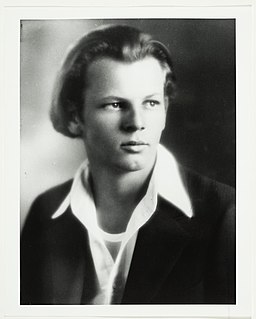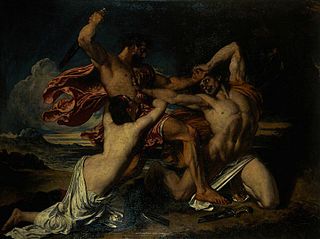Related Research Articles

Paul Jackson Pollock was an American painter and a major figure in the abstract expressionist movement. He was widely noticed for his "drip technique" of pouring or splashing liquid household paint onto a horizontal surface, enabling him to view and paint his canvases from all angles. It was also called all-over painting and action painting, since he covered the entire canvas and used the force of his whole body to paint, often in a frenetic dancing style. This extreme form of abstraction divided the critics: some praised the immediacy of the creation, while others derided the random effects. In 2016, Pollock's painting titled Number 17A was reported to have fetched US$200 million in a private purchase.
Abstract expressionism is a post–World War II art movement in American painting, developed in New York City in the 1940s. It was the first specifically American movement to achieve international influence and put New York at the center of the Western art world, a role formerly filled by Paris.

Paul Jordan-Smith was an American Universalist minister who also worked as a writer, lecturer and editor. Academically, he is regarded as one of the foremost authorities on the 17th-century British author and scholar Robert Burton. However, he is most well known for originating the hoax art movement Disumbrationism.

Hard-edge painting is painting in which abrupt transitions are found between color areas. Color areas are often of one unvarying color. The Hard-edge painting style is related to Geometric abstraction, Op Art, Post-painterly Abstraction, and Color Field painting.

James Rosenquist was an American artist and one of the proponents of the pop art movement. Drawing from his background working in sign painting, Rosenquist's pieces often explored the role of advertising and consumer culture in art and society, utilizing techniques he learned making commercial art to depict popular cultural icons and mundane everyday objects. While his works have often been compared to those from other key figures of the pop art movement, such as Andy Warhol and Roy Lichtenstein, Rosenquist's pieces were unique in the way that they often employed elements of surrealism using fragments of advertisements and cultural imagery to emphasize the overwhelming nature of ads. He was a 2001 inductee into the Florida Artists Hall of Fame.
Henriette Wyeth Hurd was an American artist noted for her portraits and still life paintings. The eldest daughter of illustrator N.C. Wyeth, she studied painting with her father and brother Andrew Wyeth at their home and studio in Chadds Ford, Pennsylvania.

Alice Neel was an American visual artist, who was known for her portraits depicting friends, family, lovers, poets, artists, and strangers. Her paintings have an expressionistic use of line and color, psychological acumen, and emotional intensity. Her work depicts women through a female gaze, illustrating them as being consciously aware of the objectification by men and the demoralizing effects of the male gaze. Her work contradicts and challenges the traditional and objectified nude depictions of women by her male predecessors. She pursued a career as a figurative painter during a period when abstraction was favored, and she did not begin to gain critical praise for her work until the 1960s. Neel was called "one of the greatest portrait artists of the 20th century" by Barry Walker, curator of modern and contemporary art at the Museum of Fine Arts, Houston, which organized a retrospective of her work in 2010.

Major Sir William Newenham Montague Orpen, was an Irish artist who worked mainly in London. Orpen was a fine draughtsman and a popular, commercially successful painter of portraits for the well-to-do in Edwardian society, though many of his most striking paintings are self-portraits.

Roland David Smith was an American abstract expressionist sculptor and painter, best known for creating large steel abstract geometric sculptures.

Florent Willems or Florent Willems van Edeghem was a Belgian painter and art restorer. He was successful with his genre scenes depicting a few figures in an interior executed in the style of the 17th century Flemish and Dutch Baroque. He was particularly praised for his ability to render realistically the materials of the clothes of his figures which earned him the nickname of the 'modern Ter Borch'.

Kehinde Wiley is an African-American portrait painter based in New York City, who is known for his highly naturalistic paintings of Black people, frequently referencing the work of Old Master paintings. He was commissioned in 2017 to paint a portrait of former President Barack Obama for the Smithsonian National Portrait Gallery, which has portraits of all previous American presidents. The Columbus Museum of Art, which hosted an exhibition of his work in 2007, describes his work as follows: "Wiley has gained recent acclaim for his heroic portraits which address the image and status of young African-American men in contemporary culture."
Zane Lewis is an American visual artist based in Brooklyn, New York. His abstract paintings and sculptures reference color field painting, pointillism, phenomenology, and minimalism. And have been stylistically referred to as 'psychedelic minimalism'.
Patrick Swift (1927–1983) was an Irish painter who worked in Dublin, London and the Algarve, Portugal.
Robert Clunie was a Scottish-American plein air painter, specializing in California landscape art with a particular focus on the rugged mountain scenery of the High Sierra.

Rinaldo Cuneo, was an American artist known for his landscape paintings and murals. He was dubbed, "the Painter of San Francisco".

Julian Ritter was an American painter of Polish-German descent who painted primarily nudes, clowns and portraits.

Percy Alexander Leason was an Australian political cartoonist and artist who was a major figure in the Australian tonalist movement. As a painter and commercial artist his works span two continents.

The Combat: Woman Pleading for the Vanquished is a large oil painting on canvas by English artist William Etty, first exhibited in 1825 and now in the National Gallery of Scotland. Inspired by the Elgin Marbles and intended by the artist to provide a moral lesson on "the beauty of mercy", it shows a near-nude warrior whose sword has broken, forced to his knees in front of another near-nude soldier who prepares to inflict a killing blow. A woman, also near-nude, clutches the victorious warrior to beg him for mercy. Very unusually for a history painting of the period, The Combat does not depict a scene from history, literature or religion and is not based on an existing artwork, but is instead a scene from the artist's own imagination.
Andy Wilf (1949–1982) was a Los-Angeles based painter whose artistic practice consisted of drawing, painting and murals.

Niagara is an oil painting by Frederic Edwin Church. Niagara was his most important work to date, and confirmed his reputation as the premier American landscape painter of the time. In his history of Niagara Falls, Pierre Berton writes, "Of the hundreds of paintings made of Niagara, before Church and after him, this is by common consent the greatest."
References
- ↑ Museum of Hoaxes, The Disumbrationist School of Art
- ↑ Bridgeford-Smith, Jan (2021). Begged, borrowed, and stolen : true tales of thievery from America's past. Rowman & Littlefield. p. 111. ISBN 9781493052325 . Retrieved 1 February 2022.
- ↑ Multiple sources:
- (27 January 1931). Pictures Painted to "Show Up" the Critics Bring Fame to Mythical Modernistic Artist, Lawrence Journal-World (Associated Press)
- (14 August 1927). INTERNATIONAL ART HOAX BARED BY LOS ANGELES AUTHOR, Los Angeles Times
- Watson, Elmo Scott (14 October 1937). Historic Hoaxes, Clinton County Times
- (19 September 1927). Fine Arts: A Thoroughly Modern Picture, Lewiston Daily Sun